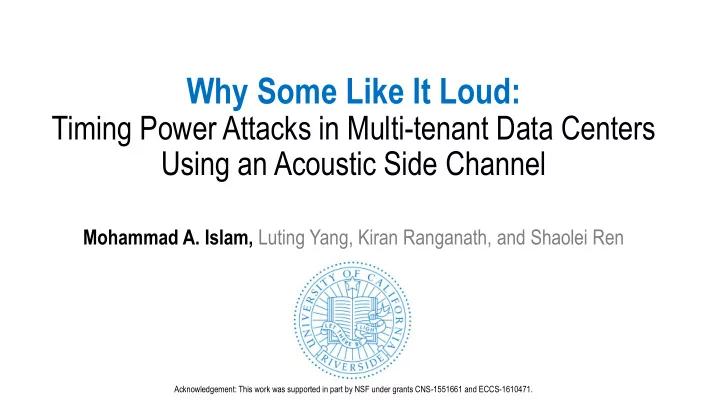

Why Some Like It Loud: Timing Power Attacks in Multi-tenant Data Centers Using an Acoustic Side Channel Mohammad A. Islam, Luting Yang, Kiran Ranganath, and Shaolei Ren Acknowledgement: This work was supported in part by NSF under grants CNS-1551661 and ECCS-1610471.
This talk is NOT about multi-tenant clouds; it’s about multi -tenant data centers! 2
This talk is NOT about multi-tenant clouds; it’s about multi -tenant data centers! P D vs U UPS P D U Tenant = virtual machines Tenant = physical servers 2
Multi- tenant data centers are everywhere… Apple houses 25% of its servers in multi- tenant data centers… 3
Multi- tenant data centers are everywhere… Google, Amazon, MS, Fb… :7.8% Multi-tenant: Enterprise: 37% 53% Percentage of electricity usage by data center type (source: NRDC 2015) 3
An overview of multi-tenant data center P D Utility U UPS ATS P D Generator U Managed by operator 4
An overview of multi-tenant data center P D Utility U UPS ATS P D Generator U Managed by operator Managed by tenants 4
An overview of multi-tenant data center P D Utility U UPS ATS Securing the cyberspace P D • DDoS attack, network intrusion, privacy Generator U protection, etc. [Mirkovic, Sigcomm’04][Zhang CCS’12][Moon CCS’15][Dong CCS’17]… Managed by operator Managed by tenants 4
P D U UPS ATS P D U Generator 5
How to attack the physical infrastructure? P D U UPS ATS P D U Generator 5
How to attack the physical infrastructure? P D U UPS ATS P D U Generator Power Overload using Human intrusion server power Hacking control systems 5
How to attack the physical infrastructure? P D U Our focus UPS ATS P D U Generator Power Overload using Human intrusion server power Hacking control systems 5
P D U UPS ATS P D U Generator 6
P D U UPS ATS P D U Generator 6
Power attack: Well-timed power injection to overload the shared P data center capacity, subject to all applicable usage D U constraints set by the operator UPS ATS P Malicious D Tenant U Generator Malicious load 6
Cost analysis More likely to have an outage during overloads (e.g., risk increases by ~280 times for a Tier-IV data center ) Million $/MW/year 25 20 15.6 15 8.7 10 3.5 5 0 Tier-II Tier-III Tier-IV Estimated cost based on 5% overloads and a data center of 1MW-10,00sqft 7
Cost analysis More likely to have an outage during overloads (e.g., risk increases by ~280 times for a Tier-IV data center ) Million $/MW/year 25 Annual cost > $2 billion 20 15.6 (if only 10% of the U.S. data centers 15 are affected) 8.7 10 3.5 5 0 Tier-II Tier-III Tier-IV Estimated cost based on 5% overloads and a data center of 1MW-10,00sqft 7
How to precisely time power attacks? 8
How to precisely time power attacks? • Random attacks are unlikely to be successful, while constant full power is prohibited 8
How to precisely time power attacks? • Random attacks are unlikely to be successful, while constant full power is prohibited • Coarse timing (e.g., based on “peak” hours) is ineffective 8
Server power Heat Cold Airflow Fan Speed Noise Dell PowerEdge servers 9
Server power Heat Cold Airflow Fan Speed Noise Dell PowerEdge servers 9
Server power Heat Cold Airflow Fan Speed Noise Dell PowerEdge servers 9
There are challenges…! 10
Suppressing the loud AC noise Serves in a data center Serves noise 11
Suppressing the loud AC noise Serves in a data center Serves noise A high-pass filter reveals the server noise pattern 11
Unknown 𝑭 (𝑵×𝑳) 𝒀 (𝑶×𝑳) 𝑩 (𝑵×𝑶) 𝒁 (𝑵×𝑳) Interest Observation 12
Unknown 𝑭 (𝑵×𝑳) 𝒀 (𝑶×𝑳) 𝑩 (𝑵×𝑶) 𝒁 (𝑵×𝑳) Interest Observation Solution: Blind source separation using non-negative matrix factorization (NMF) 12
Experimental evaluation • Experimental settings • Run real workload traces in a university data center • True positive: % of attack opportunities detected • Precision: % of an attack being successful 13
Experimental evaluation • Experimental settings • Run real workload traces in a university data center • True positive: % of attack opportunities detected • Precision: % of an attack being successful 13
Physical co-residence and space sharing result in physical side channels Can be exploited to compromise data center physical security! Thanks! 14
Recommend
More recommend